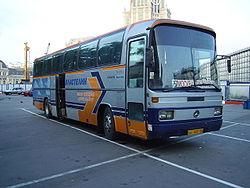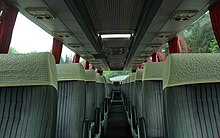Mercedes-Benz O 303
| Mercedes Benz | |
|---|---|

O 303-15RHD (from 1982) |
|
| O 303 | |
| Manufacturer | Daimler Benz |
| design type | Combined bus , coach |
| Production period | 1974-1992 |
| axes | 2 |
| power | 140-264 kW (190-360 hp ) |
| Perm. total weight | 10,000-16,000 kg |
| Previous model | Mercedes-Benz O 302 |
| successor | O 404 , O 340 |
| Similar models | Magirus-Deutz T, R and TR series, MAN SR, Neoplan City / Jetliner, Setra 200 series, Steyr-Mercedes SML 14H 256 , FAP Sanos S315 |
The Mercedes-Benz O 303 was a touring coach made by Daimler-Benz AG in the 1970s and 1980s.
In 1974 Mercedes-Benz presented the new O 303 omnibus series at the Paris Motor Show , the design of which, in keeping with contemporary tastes, was much smoother than that of its predecessor, the O 302 , but was visually very similar to this very successful model and also represented its further technical development . For the first time, however, the frame construction was carried out with the help of computer calculations, so that the construction of the O 303 represents an independent development instead of a facelift.
The O 303 was even more clearly designed as a touring coach than its predecessor, but among the many different versions within the new modular system there were still scheduled buses , combi buses for regular and occasional traffic, as well as various coaches ranging from simple equipment to high-deck long-distance coaches , which only appeared in the offer in 1979. However, the O 303 did not have a city traffic variant like the O 302, with a double-width front door and low side glazing instead of the raised panoramic windows, as the Mercedes standard O 305 and O 307 regular- service bus models had been available for this purpose since the early 1970s . The O 307 was also optionally available with excursion seating and luggage compartments, so that the O 303 ÜHP / ÜHE faced two combination models.
Technically and to a certain extent also visually, the O 303 was clearly the further development of the O 302. It had rigid axles and drum brakes throughout the construction period . On the other hand, the O 303 got newly developed V6 and V8-cylinder diesel engines , as well as a V10 with 235kW / 320PS up to the introduction of the high-decker model and the parallel truck facelift "NG 80". Right from the start, the O 303 was fitted with air suspension , which compensated for the lack of comfort of the rigid axles. Optionally, were automatic as well as during the long production time from 1981 on request the then new antilock braking system available. From 1985, the semi-automatic electropneumatic shift was offered as an option (manual six-speed gearboxes were common), which made the O 303 technically at least partially groundbreaking despite drum brakes and rigid axles. In the early years, all O 303 had front windows split vertically in the middle, a customary attribute at the time that gave the body greater rigidity thanks to the center bar and, moreover, in the event of a crack in the window, did not require replacement across the entire width of the car, only the affected side. A continuous, one-piece windscreen has been available as an option for the normal O-303 models since 1979;
The only major optical facelift took place in 1982, the front panel was now partially made of plastic and the chrome-plated “glasses” around the headlights and radiator grille were omitted, they now formed a unit with the bumper. In the passenger compartment there were changes to the overhead luggage racks, which were now closed at the bottom and had a continuous handle bar, which was previously interrupted by the deep-drawn loudspeakers. In addition, the dashboard has been completely redesigned. On request, black window frames were available on the outside, which made the side windows appear as a closed band.
The O 303 was offered in many different versions of 9, 10, 11, 13, 14 and 15 rows of seats, each with a body in six different lengths. The number of rows of seats (maximum available in length) were part of the type designation. With full seating (including folding armchair on the second door in the combination versions and omission of the toilet) up to 55 seats were offered. The number of seats varied within a vehicle length, in addition to the choice of different seat models, as well as the required minimum seat spacing from classification organizations such as the Gütegemeinschaft Bus Komfort eV (GBK), if the bus company had the bus classified with stars at its own request. The distinctions according to the type of construction and type of use were made by means of additional letter abbreviations such as KHP-L, KHP-A, R, RH, RHS, RHD, whereby after the model upgrade from 1982 a K stood for Kombibus (excursion / scheduled services) and R for coach .
From the 9-row O 303 9-R club bus to the large standard size of 15 rows, different seating and comfort features were offered, for combination and line use there were target sign boxes mounted inside the windshield as well as double-wide outer pivoting doors in the middle with a low passenger compartment floor a not unnecessarily high entry in the regular service. Furthermore, in this variant, the seats opposite the central door were attached to removable platforms in order to create a space for prams or additional standing room if necessary. A continuous handle bar under the ceiling enabled the vehicle with standing room to be approved for regular service. The normal coaches were given a higher car body and thus larger trunk under the passenger compartment, simple outer pivoting doors up to the edge of the roof (there was usually a narrow panoramic window above the rear door), the high-decker touring coaches can be recognized by a rear sheet metal door, which is below the overall high car body Window bottom ends. Usually all vehicles had a fan heater; top-mounted air conditioning systems from third-party manufacturers (e.g. Behr, Konvekta) were available for a surcharge.
In the first years of production, double-leaf doors were standard, after the model change in 1982 the doors were mostly single-leaf. For all models with a so-called single-width rear door, you could choose between a center door in front of or a rear door behind the drive axle. Most models were also available with or without a driver's door. Right-hand drive export models with passenger doors on the left-hand side were given the mandatory emergency exit door on the right-hand side for the United Kingdom , the lower edge of which was flush with the passenger compartment floor. The Bundeswehr received a large number of buses from this model series with a double-wide, four-part pivoting folding door in the middle and simple synthetic leather seats from the O 305 model range . Externally, these vehicles were also simplified; The chrome-plated hubcaps were dispensed with, the passenger compartment ventilation was simplified, and the wind deflector above the rear window was also missing. An attribute that also characterized the line versions up to 1982. There were special prisoner buses with closed cells and narrow viewing windows for transfer trips of prisoners. There were versions with a prisoner entrance door immediately behind the front axle. In this case, the front door on the passenger side was designed as a simple, manually operated revolving door and only served as entry for the accompanying staff.
V-engines were basically offered as V6, V8 and initially also as V10, which were also used in parallel in the Mercedes-Benz trucks of the NG series. The engine started at 140 kW / 190 PS and ended with the most powerful series engine of the time, the OM 403 with 235 kW / 320 PS (V10), which was discontinued with the NG80 facelift and replaced by the OM 402 A, a V8 with 243 kW / 330 hp was replaced. While normally aspirated engines were offered before the facelift , afterwards it was predominantly engines with supercharging , which ended up at 354 hp in the last years of production.
In 1992 the O 303 was replaced by the newly designed O 404 . The production facilities for the O 303 were then sold to Russia , where the model continued to be built for a few years. In Turkey, where the O 303 - with a different body - was also manufactured, appeared in 1992 as an optically unmistakable further development of the old type of O 340 . With around 38,000 vehicles built, the O 303 is still the world's most successful touring coach. To a large extent, however, this also includes chassis for bodybuilders. One of them was Steyr Daimler Puch with over 1000 intercity buses of the type SML 14H 256 . The O 303 was also manufactured under license by Hyundai under the same name .
See also
Web links
- Manufacturer's film about the development of the O 303 series on OmnibusRevue from the 1970s
- The O 303: buses from the modular system. Global Media Site of Daimler AG, accessed on September 21, 2017 .
| Vehicle class | 1920s | 1930s | 1940s | ||||||||||||||||
| 6th | 7th | 8th | 9 | 0 | 1 | 2 | 3 | 4th | 5 | 6th | 7th | 8th | 9 | 0 | 1 | 2 | 3 | 4th | |
| Compact class | W 15 (type 170) | ||||||||||||||||||
| W 23 (type 130) | |||||||||||||||||||
| W 30 (type 150) | |||||||||||||||||||
| W 28 (type 170 H) | |||||||||||||||||||
| Middle class | W 02 (type Stuttgart 200) | W 136 / W 149 (types 170 V / 200 V) | |||||||||||||||||
| W 11 (type Stuttgart 260) | W 143 (type 230 n) | ||||||||||||||||||
| W 21 (type 200/230) | W 153 (type 230) | ||||||||||||||||||
| W 138 (type 260 D) | |||||||||||||||||||
| upper middle class | W 03 / W 04 / W 05 (types 300/320/350) | W 18 (type 290) | |||||||||||||||||
| W 10 / W 19 (types 350/370/380) | W 142 (type 320) | ||||||||||||||||||
| W 22 | |||||||||||||||||||
| Upper class | Type 400 & Type 630 | W 24 / W 29 / W 129 (types 500 K / 540 K / 580 K) | |||||||||||||||||
| W 08 (type Nürburg 460/460 K / 500 / type 500 N) | |||||||||||||||||||
| W 07 / W 150 (types 770/770 K) | |||||||||||||||||||
| Sports car | Model K | ||||||||||||||||||
| W 06 (type S / SS / SSK / SSKL) | W 24 / W 29 / W 129 | ||||||||||||||||||
| Off-road vehicle | W 103 (type G1) | W 31 (type G4) | |||||||||||||||||
| W 133 III (type 170 VG) / W 139 (type 170 VL) / W 152 (type G5) | |||||||||||||||||||
| Vans | L 3/4 | L 1000 Express | L 301 | ||||||||||||||||
| L 300 | |||||||||||||||||||



